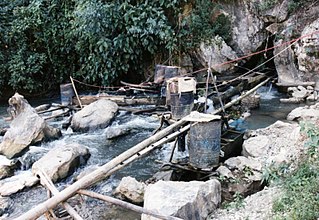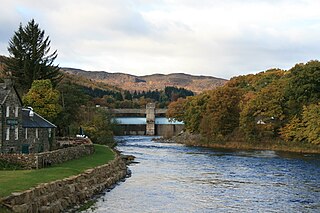
Kilmarnock is a town and former burgh in East Ayrshire situated in southwest Scotland. The town has served as the administrative centre of East Ayrshire Council since 1996 and is the region's main commercial and industrial centre. The town has a total of 284 listed buildings and structures as designed by Historic Environment Scotland, including the Dick Institute, Dean Castle, Loanhead School and the original 1898 building of Kilmarnock Academy, with post–war developments of the controversial 1970s regeneration such as The Foregate and Clydesdale Bank building being considered for listed building status.

Loch Rannoch is a freshwater loch in Perth and Kinross, Scotland. It is over 15 kilometres (9.3 mi) long in a west–east direction with an average width of about 1.2 kilometres (0.75 mi), and is deepest at its eastern end, reaching a depth of 130 metres (440 ft). The River Tummel begins at its eastern end, where the small village of Kinloch Rannoch can be found, whilst the wild expanse of Rannoch Moor extends to the west of the loch. The area surrounding Loch Rannoch, along with Rannoch Moor itself, was formerly part of the native Caledonian Forest that stretched across much of Northern Scotland. Native forest is now largely absent from much of the area, due partly to logging, and partly to the climate becoming wetter, and Loch Rannoch is now largely surrounded by commercial forestry and open hillsides, although a small area remains at the Black Wood of Rannoch on the southern shore of the loch.

The Petty Harbour Hydro Electric Generating Station is a hydroelectric generating station in Petty Harbour–Maddox Cove, Newfoundland and Labrador. It was constructed in 1898 and it was the first hydroelectric generating station in Newfoundland. It was built by the St. John's Street Railway Company, a company established by Robert Reid. Operation commenced on 19 April 1900.

New Bullards Bar Dam is a variable radius concrete arch dam constructed in the early 1960s in California on the North Yuba River. Located near the town of Dobbins in Yuba County, the dam forms the New Bullards Bar Reservoir, which can hold about 969,600 acre⋅ft (1.1960×109 m3) of water. The dam serves for irrigation, drinking water and hydroelectric power generation.

Micro hydro is a type of hydroelectric power that typically produces from 5 kW to 100 kW of electricity using the natural flow of water. Installations below 5 kW are called pico hydro. These installations can provide power to an isolated home or small community, or are sometimes connected to electric power networks, particularly where net metering is offered. There are many of these installations around the world, particularly in developing nations as they can provide an economical source of energy without the purchase of fuel. Micro hydro systems complement solar PV power systems because in many areas water flow, and thus available hydro power, is highest in the winter when solar energy is at a minimum. Micro hydro is frequently accomplished with a pelton wheel for high head, low flow water supply. The installation is often just a small dammed pool, at the top of a waterfall, with several hundred feet of pipe leading to a small generator housing. In low head sites, generally water wheels and Archimedes' screws are used.

Floodgates, also called stop gates, are adjustable gates used to control water flow in flood barriers, reservoir, river, stream, or levee systems. They may be designed to set spillway crest heights in dams, to adjust flow rates in sluices and canals, or they may be designed to stop water flow entirely as part of a levee or storm surge system. Since most of these devices operate by controlling the water surface elevation being stored or routed, they are also known as crest gates. In the case of flood bypass systems, floodgates sometimes are also used to lower the water levels in a main river or canal channels by allowing more water to flow into a flood bypass or detention basin when the main river or canal is approaching a flood stage.

Loch Tummel is a long, narrow loch, seven kilometres northwest of Pitlochry in the council area of Perth and Kinross, Scotland. It is fed and drained by the River Tummel, which flows into the River Tay about 13 km (8 mi) south-east of the Clunie Dam at the loch's eastern end.
The Temenggor Dam or Temenggor Hydro-Electric Project or Temenggor Power Station is a dam in Gerik, Perak, Malaysia. It is located on Perak River about 200 km northeast of Ipoh. Construction of the dam impounded Temenggor Lake.
The Wayatinah Power Station is a run-of-the-river hydroelectric power station located in the Central Highlands region of Tasmania, Australia. The power station is situated on the Lower River Derwent catchment and is owned and operated by Hydro Tasmania.

The Tungatinah Power Station is a conventional hydroelectric power station located in the Central Highlands region of Tasmania, Australia. The power station is situated on the Upper River Derwent catchment and is owned and operated by Hydro Tasmania.

The Tummel hydro-electric power scheme is an interconnected network of dams, power stations, aqueducts and electric power transmission in the Grampian Mountains of Scotland. Roughly bounded by Dalwhinnie in the north, Rannoch Moor in the west and Pitlochry in the east it comprises a water catchment area of around 1,800 square kilometres and primary water storage at Loch Ericht, Loch Errochty, Loch Rannoch and Loch Tummel, in Perth and Kinross. Water, depending on where it originates and the path it takes, may pass through as many as five of the schemes nine power stations as it progresses from north-west to south-east. The scheme was constructed in the 1940s and 50s incorporating some earlier sites. It is managed by SSE plc.

Dunalastair Water is an entirely man made reservoir in Scotland which lies between Loch Rannoch and Loch Tummel in Strath Tummel in Perth and Kinross council area. The loch provides water power for the Tummel hydroelectricity power station and has the reputation as one of the best wild trout fishing locations in the United Kingdom.

The Ponmudi Dam is a concrete gravity dam built across the Panniyar river which is a tributary of Periyar river at Konnathady panchayath of Konnathadi village in Idukki district of Kerala, India. The dam was constructed in 1963 as a part of a hydroelectric project. Construction was led by E.U.Philipose, Superintending Engineer, Kerala State Electricity Board. It has a length of 288.80 metres (947.5 ft). The hydropower component of the dam has an installed capacity of 30 MW with firm power of 17 MW, generating 158 GWh annually. Taluks through which the river flow are Udumbanchola, Devikulam, Kothamangalam, Muvattupuzha, Kunnathunadu, Aluva, Kodungalloor and Paravur.
Mueller Co. is a Chattanooga, Tennessee based industrial manufacturing group that manufactures fire hydrants, gate valves, and other water distribution products. Mueller Co. which moved to Chattanooga from Decatur, Illinois in 2010, is the largest supplier of potable water distribution products in North America. Mueller Co. is a subsidiary of Mueller Water Products, Inc. A manufacturing facility remains in Decatur.

The Bihai Power Plant is a hydroelectric power plant in Xiulin Township, Hualien County, Taiwan.

The Pupu Hydro Power Scheme is a small hydroelectric power station near Tākaka in the Golden Bay region of the South Island of New Zealand. It opened in 1929 as the first power station in the region and was the first public electricity supply in Golden Bay. After closing in 1980 following damage to the generator, the power scheme was fully restored by the local Pupu Hydro Society and many volunteer groups over the course of seven years and re-opened in 1988, again supplying electricity to the national grid.

The Erathna Mini Hydro Power Project is one of the run of river mini hydro power projects in Sri Lanka which has the install capacity of 10 MW. The project is located on the Kuru Ganga, a tributary of the Kalu Ganga.
Marjorie Jean Oswald Kennedy was a Scottish librarian who worked at the Bletchley Park code-breaking base during the Second World War and was the moving force behind the creation of The Rock Trust, a Scottish charity for young homeless people.

Kakki Dam is a concrete gravity dam built on the Kakki river, a tributary of the Pampa river in the Ranni forest in the Seethathodu panchayat of Pathanamthitta district in Kerala, India. The dam is located in a forested area adjacent to the Periyar National Park. It was built in 1966 as part of the Sabarigiri Hydroelectric Project. The water sources of the dam are from the Pampa dam and the Kakki river. The Sabarigiri project envisaged creation of two reservoirs which are Pamba and Kakki reservoirs and connecting these together to form a single source of water. The water from Pamba reservoir is connected to the Kakki reservoir through an underground tunnel of length 3.21 km. The intake of the Sabarigiri Powerhouse is from Kakki reservoir. The dam is 336 metres (1,102 ft) long and 116 metres (381 ft) high and is located at an elevation of 981.45 metres (3,220.0 ft) above sea level. The release flows through Ranni, Konni, Kozhencherry, Thiruvalla, Chengannur, Kuttanadu, Mavelikara and Karthikappally taluks before emptying into the Vembanad lake.
The Kuratau power station is a hydroelectric power facility in Kuratau on the western side of Lake Taupō in New Zealand which makes use of water from the Kuratau River. The river is impounded behind a dam to form Lake Kuratau before discharging through the power station back into the river. The scheme is operated by Trustpower on behalf of its owner King Country Energy.

















